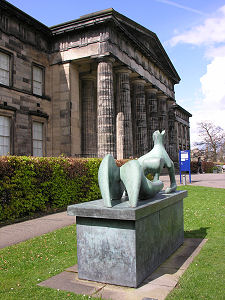 Church of St John the Evangelist, Edinburgh |
William Burn lived from 20 December 1789 to 15 February 1870. He was an architect who pioneered the Scots Baronial style. The wider picture in Scotland at the time is set out in our Historical Timeline. You can browse books about Architecture in our Bookshop.
William Burn was born in Edinburgh, the son of architect Robert Burn. He was educated at the Royal High School of Edinburgh and then trained as an architect under Robert Smirke in London, the man who was later knighted for his work on the British Museum. Burn returned to Edinburgh in 1812 at the age of 25, and set up in practice as an architect.
In 1825 he took on David Bryce as a pupil and in 1841 the two became business partners. Burn is often seen as one of the pioneers of a new style of building which became increasingly popular through the 1800s and which later fully evolved in the hands of David Bryce: Scots Baronial. This has been defined as "part of the Gothic revival in architectural styles, drawing on stylistic elements and forms from castles, tower houses and mansions of the Renaissance period in Scotland". It came to the fore in the aftermath of the visit to Scotland by George IV in 1822, during a period that, largely thanks to the writings of Sir Walter Scott, saw a resurgence in interest in a separate Scottish identity: a period during which what had often become referred to as "North Britain" became, once more, "Scotland".
To put this more practically, the Scottish Baronial style was typified by large comfortable mansions designed closely around the needs of their owners, and fitted carefully into a wide variety of landscapes. Stylistically, Scottish Baronial harked back to what was believed to be a "golden era" of Scottish architecture. The result was grand houses that borrowed features from castles of an earlier era: of towers and turrets (or, often, of towers with turrets); of highly irregular rooflines; of pinnacles; of battlements; of crowstepped gables; of lancet windows; of porticos that imitated portcullises; and of heraldic shields and other decoration.
In 1844 a dispute between William Burn and David Bryce over a commission to build St Mary's Church in Dalkeith for the Duke of Buccleuch led to their dissolving the partnership, and William Burn moved to London, where he died in 1870.
Although associated with the Scots Baronial style, Burn was a highly versatile architect. He certainly had a hand in building or remodelling a large number of country houses, but he was also responsible for a number of churches, notable the Church of St John the Evangelist, on Prince's Street in Edinburgh; for colleges, including John Watson's Hospital, which is now the Scottish National Gallery of Modern Art, Edinburgh; and for hotels, hospitals and other buildings such as the Glasgow General Post Office.

